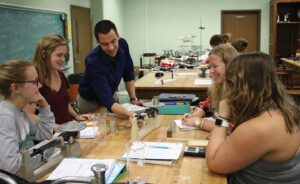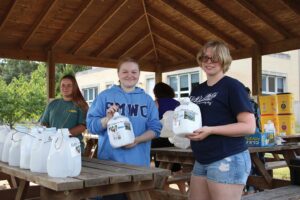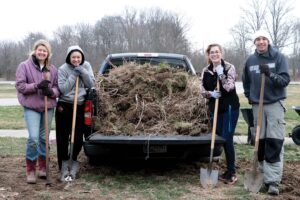
By William Riley
When she graduates next May, Olivia Swickard will likely not devote her career to sustainability. She will not discover a new way of recycling plastics or study the effects of trash on Midwestern ecosystems. A human services major and psychology minor, she simply doesn’t have the training to study these topics scientifically.
Instead, Swickard will do what she’s always done at Saint Mary-of-the-Woods College: change the way those around her think about sustainability.
Confused? Then you don’t know Swickard or the incredible sustainability initiatives underway at Saint Mary-of-the-Woods College.
To get to the office of Assistant Professor Dennis Tarasi, Ph.D.—the one with the posters of invasive species covering the famous cinderblock walls of Hulman Hall—you first have to find the turtle. Finding the turtle and finding his office will not guarantee that you’ll find Tarasi. The smart money is that he’s in a meeting. As the faculty member who directs the major and minor in environmental science program, he is often meeting with the Greening The Woods committee, the Sustainability Club (Olivia Swickard? She’s the president.) or students who are working to understand how the biodiversity of Le Fer Lake has changed since the lake was drained and dredged to repair a failing dam. Or he may be working with students in Woods Core classes to develop sustainability projects that leave a great impact on campus.
But the turtle? He’ll be there. He’s been there long before Tarasi arrived nearly two years ago. The stories about the turtle are apocryphal at this point. Like who the turtle is: he’s either named Watson or Crick, there used to be a Watson and a Crick but one of them died when they were very young and nobody is sure which died and which lived. This turtle is still thriving, though. There’s something about these Woods that sustains.
What is it about these Woods that sustains? It’s the people. When Swickard was a first-year student, she joined the Sustainability Club to have something to do and people to meet. She remembers her first Wabashiki cleanup—an annual Sustainability Club event where members meet at Dewey Point in West Terre Haute to clean up the Wabashiki wetlands preserve— as eyeopening.
“When we left that day, there was a dumpster full of odd items, stuff like tires and needles,” she says. When she returned to her Le Fer Hall room that evening, she thought about the experience. “You see videos of turtles with straws in their noses and animals losing their homes. It got me worried that we might one day lose our homes if we don’t do something.”

Thanks to the small campus size and an affirmed value of sustainability, Saint Mary-of-the-Woods College makes it easy for students to do something, even if that something isn’t easy in and of itself. Swickard, now president of the Sustainability Club, has helped to lead new initiatives like a Ring Day campus cleanup and improved awareness of recycling on campus. When club members noticed that recycling materials wasn’t as easy for housekeeping staff as it could be, the club stepped in to make the process more efficient and to let students, faculty and staff know how to dispose of particular recyclable items.
“That’s what’s different about a small school like The Woods,” says Tarasi. “It’s very easy for you to get involved and see your ideas come to fruition. There are few layers of oversight, and students get the ability to be leaders and see the impact of their ideas.”
Did Swickard find a new way to recycle that will eradicate all waste moving forward? No. But she led her student club to improve how we treat our earth—even just a little bit. Suddenly, students, staff and faculty are cleaning up the grounds before Ring Day and noticing less and less trash on Wabashiki cleanup day. When considering the impact on the entire earth, the actions of the club are minute. But, as Swickard knows, if everyone did a little more, we’d be in better shape. These efforts have helped Swickard understand what she wants to do post-graduation, dealing with clients as a human services professional.
“I’ve learned how to teach other people how to do something,” Swickard says, reflecting on her Sustainability Club experience. “Now I know that there are all these events that my future clients can get involved in. There are things they can do in their daily lives that cost nothing but have an impact on our earth. I can teach them how to do those things when I leave The Woods.”
Saint Mary-of-the-Woods College is unique when it comes to sustainability. One of our four core values is sustainability, which means that students are introduced to sustainability academically in their first year and can choose to take a capstone course in sustainability, usually in their junior or senior year. For first-year students, the sustainability unit of “Into the Woods” — Woods Core (WC) 100 — often allows students to perform hands-on work in sustainability. Since all students must perform a service project, many choose to lead initiatives aimed at making campus a greener place.
One initiative that the first-year students in WC 100 led last year was a trayless week in the O’Shaughnessy Dining Room. Trayless programs are nothing new—many schools have moved to trayless dining since it limits food waste (people get less food when they have to carry it by hand) and saves water since there are no trays to clean. So what was different about Trayless Week at The Woods?
“It was quiet,” Tarasi explains. Usually, trayless initatives are met with some amount of consternation, since it can be a bit inconvenient. Other schools have had their trayless initiatives met with protest. Tarasi smiles when he recalls how smoothly the trial week—and the resulting final decision to go trayless permanently—went. “Greening The Woods committee worked really hard and led the College in adopting the trayless program permanently. WC100 students did a great job of educating campus before the trial week.” Students sent e-mails, hung posters, and stood by the trays to explain why trayless dining was a good idea.
“That’s another thing that’s different about this school,” Tarasi says. “The students themselves are learning how to lead, how to delegate and then how to execute. They take joy in getting people to be enthusiastic about these programs.”
That execution extends beyond The Woods. When McKayla Tichenor, who will graduate in May, took the sustainability capstone—or Woods Core 402—she didn’t expect that it would change the way her rural Vigo County family would deal with trash. But, after learning about sustainability in WC 402, she realized how sustainability affects all aspects of life.
“I had no idea how sustainability was connected to social justice, for example,” Tichenor says. “Sustainability isn’t just about going green. People think it’s some daunting thing, but throughout the class we learned how our small choices added up.”

Caitlyn Granfield ’17 of Kokomo, Ind., and Assistant Professor of Ecology
Dennis Tarasi, Ph.D., work on preparing the ground for the pollinator garden
behind Hulman Hall.
Tichenor explains that since her family lives far out in the country, they used to burn their trash. But after the class?
“We’re taking the time to separate our trash and recycle the plastics, aluminum cans and cardboard,” she explains. “We made the decision to make a conscious effort.”
The sustainability unit in the WC 100 class and the campus projects created by WC 402 students (Tichenor built a pollinator garden behind Hulman Hall) has students looking for more ways to incorporate sustainability in their academic life. Enter Tarasi again —the environmental science major and minor are attracting students from across the campus, mainly because of the applied nature of the degree. Tarasi, himself an ecologist, sees great value in environmental science.
“Environmental science is broader than ecology. It’s interdisciplinary and applied,” Tarasi says. “We think about how these ecology and science issues relate to humans, and we want to expose students to broad perspectives. Our majors are thinking about how our world is working, and that opens up new avenues to understand our world in a different way.”
While environmental science is thriving at The Woods (an outdoor classroom will soon be built next to Le Fer Lake), just like Swickard and Tichenor, you don’t have to be a scientist to make a difference with sustainability. In fact, that is the point of such an interdisciplinary, liberal arts-based degree: there are things we can all do in our lives and careers to make a difference.
Those opportunities extend to alumni. Tarasi is forming a climate action plan with members of the Sisters of Providence, faculty and staff of Saint Mary-of-the-Woods College, and others in the larger community. Tarasi hopes that the action steps identified by the climate action plan will be carried about by all in the SMWC community, even alumni. Swickard hopes to see more alumni help with Ring Day and Founders Day cleanup projects, the Wabashiki cleanup and Week of Service this year.
Tarasi, for one, is relishing his experience working in the unique environment at Saint Mary-of-the-Woods College.
“Our size gives our students and alumni opportunities to be advocates,” he says, looking out his window. “We get the chance to work on something greater than ourselves.”
